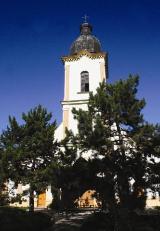Satu Mare - The Greek Catholic Church of “St. Nicholas” Mintiu
Document tools
 The first “Greeks” arrived in Satu Mare and Mintiu after Oradea was conquered in 1660. During that period, the term “Greek” wasn’t denominating an ethnic or a confessional group, but the Christian population in general, under the Turk domination (merchants, craftsmen). They came from the Balcan Peninsula, no matter if they were Greeks, Slavs or Romanians. The Greek inhabitants of the two towns received a privilege from the Emperor Leopold I, in 1667, which approved the construction of a church, on the condition of accepting the union with the Roman Catholics. Demetrius Monasterli, the Greek priest, financially supported the building of the first wooden church made in 1683. It was consecrated on the presence of Johannes Josephus de Camellis, the bishop of Mukacevo, in 1690. The community suffered many damages during the revolt of Francisc Rákóczi II. The German garrison of the fortress of Satu Mare has set the town on fire, destroying it together with the Greeks’ church. Rákóczi ordered the Greek inhabitants to leave the town and move to Tokaj, after the attack. There were three Greek families left in town in 1711. Later on, sixty Greek families were living in Satu Mare, in 1734.
The first “Greeks” arrived in Satu Mare and Mintiu after Oradea was conquered in 1660. During that period, the term “Greek” wasn’t denominating an ethnic or a confessional group, but the Christian population in general, under the Turk domination (merchants, craftsmen). They came from the Balcan Peninsula, no matter if they were Greeks, Slavs or Romanians. The Greek inhabitants of the two towns received a privilege from the Emperor Leopold I, in 1667, which approved the construction of a church, on the condition of accepting the union with the Roman Catholics. Demetrius Monasterli, the Greek priest, financially supported the building of the first wooden church made in 1683. It was consecrated on the presence of Johannes Josephus de Camellis, the bishop of Mukacevo, in 1690. The community suffered many damages during the revolt of Francisc Rákóczi II. The German garrison of the fortress of Satu Mare has set the town on fire, destroying it together with the Greeks’ church. Rákóczi ordered the Greek inhabitants to leave the town and move to Tokaj, after the attack. There were three Greek families left in town in 1711. Later on, sixty Greek families were living in Satu Mare, in 1734.  A second wooden church was built in 1740, being replaced with a new stone church in 1757. The church had one nave, the tower was added to the western façade. Two lateral apses were built, and the ceiling was made with cassettes. The ceiling weakened almost to collapse at the end of the 19th century, therefore, the community decided to build a new church. In spite of this, the accepted project, made by Sándor Fogarassy, proposed a renovation in 1900. The new tower and the main entrance were transferred to the southern side of the nave, the two lateral apses were removed, and on the western side a new apse was made in order to assure the symmetry of the eastern and western wings of the church. A chapel was built on the northern side. The furniture was replaced during renovation. The Greek Catholic parish was abolished with the coming to power of the communist regime in 1948, the rebirth of the church was possible only after 1989. A new renovation of the edifice was started in 1990, building an octagonal nave on the northern side, a sanctuary and two vestries, and under the nave was made an underground church. The dome of the nave was made in early Byzantine style. The decorations of the edifice (the colored glass windows and the altar screen) are not finished yet. The eastern apse and part of the old wall of the nave is preserved from the baroque church. (TSz).
A second wooden church was built in 1740, being replaced with a new stone church in 1757. The church had one nave, the tower was added to the western façade. Two lateral apses were built, and the ceiling was made with cassettes. The ceiling weakened almost to collapse at the end of the 19th century, therefore, the community decided to build a new church. In spite of this, the accepted project, made by Sándor Fogarassy, proposed a renovation in 1900. The new tower and the main entrance were transferred to the southern side of the nave, the two lateral apses were removed, and on the western side a new apse was made in order to assure the symmetry of the eastern and western wings of the church. A chapel was built on the northern side. The furniture was replaced during renovation. The Greek Catholic parish was abolished with the coming to power of the communist regime in 1948, the rebirth of the church was possible only after 1989. A new renovation of the edifice was started in 1990, building an octagonal nave on the northern side, a sanctuary and two vestries, and under the nave was made an underground church. The dome of the nave was made in early Byzantine style. The decorations of the edifice (the colored glass windows and the altar screen) are not finished yet. The eastern apse and part of the old wall of the nave is preserved from the baroque church. (TSz). Printable version
Printable version
 Send as email
Send as email
